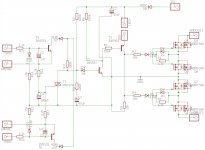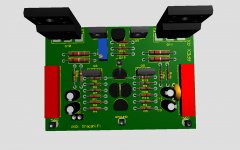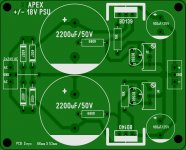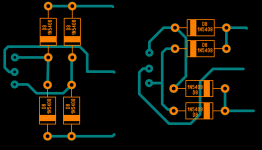I remember reading an article, that mosfet's parallel very easily, they share current immediately, no need mR current share resistors in this kind of situation.
I have tested ORIGINAL protection circuit(4xIRF540) on extreme situations also... allowing 8 AMPERE DC flow trough 2x IRF540 mosfet for 5-10 seconds or so.
Results: Nothing happens with the protection, no failure of mosfet's.
Remember, DO not trust the Short-Circuit protection in quasi-complementary NAIM-like circuits... There is 50-50 chance, that Apex will turn off the mosfets when NAIM output gets shorted. Why? Because only ONE output transistor will start to conduct current when shorted and You will NEVER know which Output Transistor will start self-destroying!
DC protection works Flawlessly on every design 🙂
I have tested ORIGINAL protection circuit(4xIRF540) on extreme situations also... allowing 8 AMPERE DC flow trough 2x IRF540 mosfet for 5-10 seconds or so.
Results: Nothing happens with the protection, no failure of mosfet's.
Remember, DO not trust the Short-Circuit protection in quasi-complementary NAIM-like circuits... There is 50-50 chance, that Apex will turn off the mosfets when NAIM output gets shorted. Why? Because only ONE output transistor will start to conduct current when shorted and You will NEVER know which Output Transistor will start self-destroying!
DC protection works Flawlessly on every design 🙂
Attachments
i always ended up with hum when testing this protection circuitI remember reading an article, that mosfet's parallel very easily, they share current immediately, no need mR current share resistors in this kind of situation.
I have tested ORIGINAL protection circuit(4xIRF540) on extreme situations also... allowing 8 AMPERE DC flow trough 2x IRF540 mosfet for 5-10 seconds or so.
Results: Nothing happens with the protection, no failure of mosfet's.
Remember, DO not trust the Short-Circuit protection in quasi-complementary NAIM-like circuits... There is 50-50 chance, that Apex will turn off the mosfets when NAIM output gets shorted. Why? Because only ONE output transistor will start to conduct current when shorted and You will NEVER know which Output Transistor will start self-destroying!
DC protection works Flawlessly on every design 🙂
Dear Mile,
Can you kindly post the schematic that corresponds with the above layout, part numbers and all ? All the schematics I have are without part Numbers !
--gannaji
Can you kindly post the schematic that corresponds with the above layout, part numbers and all ? All the schematics I have are without part Numbers !
--gannaji
Last edited:
Just finished the second channel of FH9 HV. Waiting for another Pentium heatsink to arrive from eBay... This one went together fast.
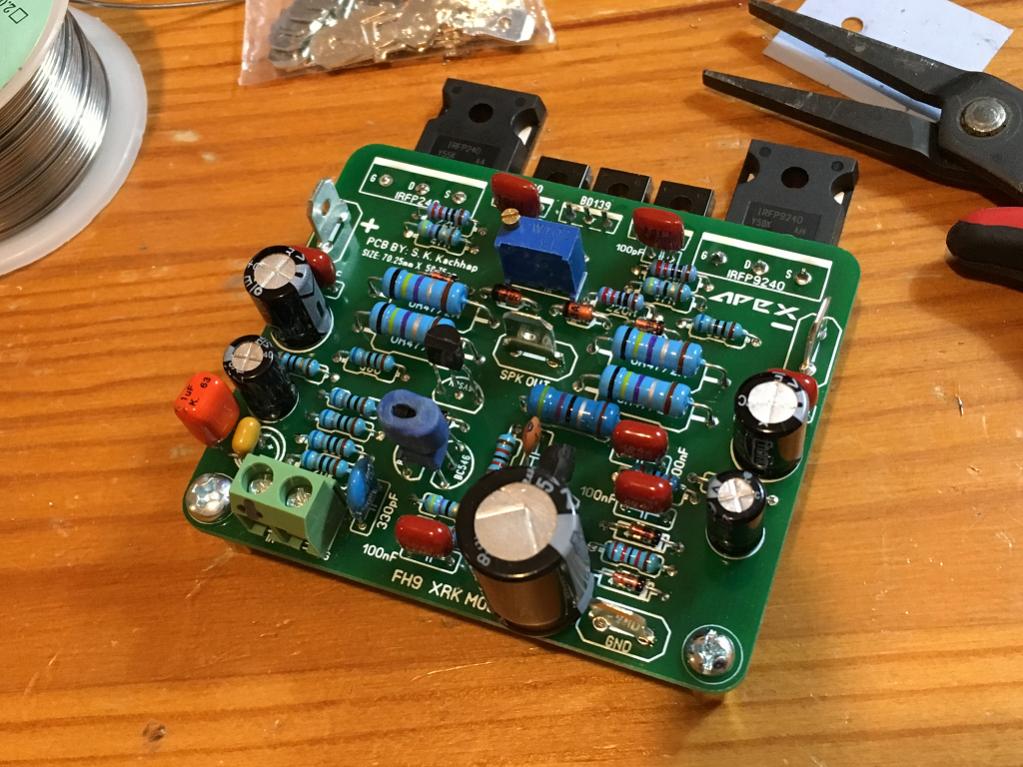
I am using IRFP's from Digikey for this one and noticed they look exactly like the ones from Aliexpress. Same markings, same quality of epoxy and fine satin finish on pins and heatsink tab. Digikey package says origin: China 🙂
Update: second channel verified to work. Initial startup at 35v rails, then moved to 52v rails. Started right up no issues - bias at 175mA and playing music nicely. I had to borrow the heatsink from the first channel while waiting for one to arrive.
This amp is truly easy to build.
Simple +/-18V regulated PSU without zeners.
What is voltage ripple for this PSU? How is the regulation achieved without a voltage reference?
Simple +/-18V regulated PSU without zeners.
Mr. Mile, How does it compare (in performance) with your A-class PSU or shunt regulator? As reported by members here, A-class is best.
reg
Prasi
What is voltage ripple for this PSU? How is the regulation achieved without a voltage reference?
Vbe of BC550/560 is voltage reference, ripple is ok but this regulator have low HF noise compare to zener reference regulators.
Mr. Mile, How does it compare (in performance) with your A-class PSU or shunt regulator? As reported by members here, A-class is best.
reg
Prasi
A-class PSU is shunt regulator and it is the best regulator for audio, low HF noise and low output impedanse compare to serial regulators.
Regulators with high feedback like 78XX/79XX is not good for audio.
Simple +/-18V regulated PSU without zeners.
Mr. Mile, what would need to be changed for +/-12V operation. I realize that I would need to use a lower voltage transformer for less heat.
Thanks...
Mr. Mile, what would need to be changed for +/-12V operation. I realize that I would need to use a lower voltage transformer for less heat.
Thanks...
Use 12k resistors instead 18k, you can use 1k pot instead 680R and set voltage.
Regards
Mr. Mile, can be this PCB ?
It's my first one in life, i think its nod bad... 😕
Certainly not bad for a first board.😉
Did you use Sprint Layout?
A newbie after more than 20 years of break
Hi Prasi,
I just tried to find a suggestion for a replacement for an ancient mini-crescendo (Elektor). Ofc the replacement should not have lower quality than the Elektor amplifierer and, on the other hand, it must fit in a place 100mm x 80 mm (including power transistor) with the mounting plane (of the board) for cooling. The power supply isn't stabalized and the transformator is 2x35V. The amplifier should have output power between 50W (into 8 Ohms) and less than 100W (into 4 Ohms).
I saw that the community here is very active, that means, if I would check all, I had to read about 2 x 700 pages. I read already a few evenings but still have the feeling I got only a tiny fraction of what I should know (Olaf already suported me a little). I got the feeling that the PeeCeeBee or an FX8 mod prasi or mod BIMO could be a good decision. Can you confirm that?
Another point is the sound quality.. I saw with both amplifiers great measuring figures. Though the audio impression depends on personal taste and other components beside the amplifier, it seems important to me.
In the quoted post, I read that u built both types, so u must have had the opportunity to compare them. Would u like to tell me your impression?
I have bought the said laterals locally. I have used them in VSSA, PEECEEBEE and now FX-8. no issues. if anyone wants, I can give address/ph. no. of vendor, they may even ship to you, if you order sufficient qty.
Hi Prasi,
I just tried to find a suggestion for a replacement for an ancient mini-crescendo (Elektor). Ofc the replacement should not have lower quality than the Elektor amplifierer and, on the other hand, it must fit in a place 100mm x 80 mm (including power transistor) with the mounting plane (of the board) for cooling. The power supply isn't stabalized and the transformator is 2x35V. The amplifier should have output power between 50W (into 8 Ohms) and less than 100W (into 4 Ohms).
I saw that the community here is very active, that means, if I would check all, I had to read about 2 x 700 pages. I read already a few evenings but still have the feeling I got only a tiny fraction of what I should know (Olaf already suported me a little). I got the feeling that the PeeCeeBee or an FX8 mod prasi or mod BIMO could be a good decision. Can you confirm that?
Another point is the sound quality.. I saw with both amplifiers great measuring figures. Though the audio impression depends on personal taste and other components beside the amplifier, it seems important to me.
In the quoted post, I read that u built both types, so u must have had the opportunity to compare them. Would u like to tell me your impression?
I am building VSSA next and have built FX8 and FX8 Bimo. I think the vertical FET FH9 sounds better - more bass authority and cleaner sounding than lateral FET FX8.
Certainly not bad for a first board.😉
Did you use Sprint Layout?
Yes i use Sprint Layout 6
Now is better ?
Attachments
Yes i use Sprint Layout 6
Now is better ?
You make it without jumper.
Attachments
Last edited:
Yes i use Sprint Layout 6
Now is better ?
I don't think the 680 ohm resistors should be under the capacitors.🙂
- Home
- Amplifiers
- Solid State
- 100W Ultimate Fidelity Amplifier

